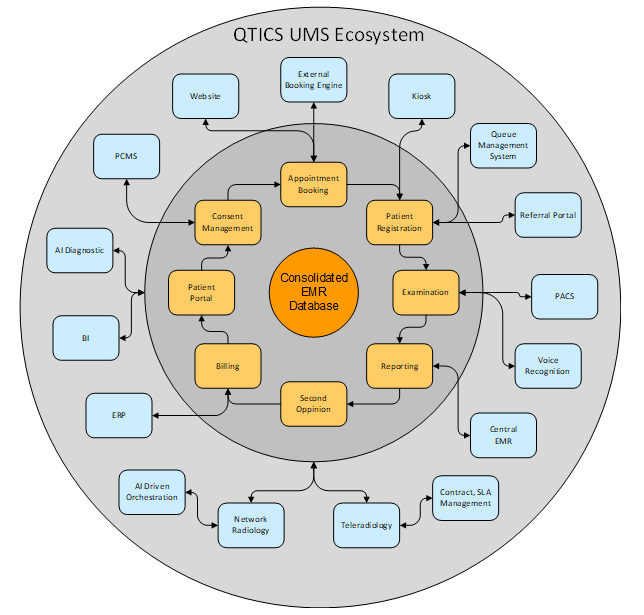Unified Medical System (UMS)
The Unified Medical System (UMS) is a new, compact, innovative and future-proof medical system that provides a solution for digitization of the entire patient pathway, where processes and the EMR (Electronic Medical Record) structure can be easily customised, integratable and scaled according to the need of the Medical Service providers, regardless of the number of entities, countries and processes that they have in place, by following the medical standards.
1. Challenges
Current market conditions compel companies to expand their services to as many areas as possible, requiring them to operate an ever-growing number of systems. Additionally, the reality of accelerated market consolidation (M&A), drives companies to swiftly acquire competition together with their legacy systems, which in turn increases the total number of systems, inflates the overall support costs and is likely to introduce new risks.
Furthermore, the customization of Out Of the Box products consumes significant costs and takes a lot of time. The accelerated market conditions and the constantly emerging new legal requirements result in continuous iteration, so the related developments never end and the relevant costs continuously impact the bottom line.
We understood that current Healthcare EMR Solutions cannot fully and comprehensively satisfy the needs of their clients:
- These systems were developed to fit their specific specialty only (Radiology, Outpatient, Occupational Health, Laboratory, etc.) and do not seamlessly scale through services, entities or geographies (local specifics around regulations).
- Common problem especially for bigger / multinational medical services providers is that their current solutions are very fragmented and rarely possess the interoperability capability to create an ecosystem. In spite of given standards data harmonization across different systems is very complex and difficult to integrate with 3rd party software.
- From financial perspective development of additional requirements is generally very costly. From business perspective the available products do not cover the entire digital patient pathway and customisation of specific needs are complicated, usually the velocity of the changes is not acceptable and expensive too.
- From IT perspective it is cumbersome to manage and deploy the changes and to provide proper support for the medical applications.
2. UMS Concept
The concept of UMS addresses the above-mentioned challenges by implementing a unique approach.
- Business specialty agnostic – can support any number of different business lines, processes, and unlimited number of legal entities
- Geography agnostic – local specifics are well controlled and modularly deployed.
- Agility in deployment and evolution – modular construct allows to rapidly respond to changing business demand.
- Cost efficient – development costs are being kept low, hence optimizing the costs and their predictability.
- Focus where it matters – Ease of use for Patient (Patient Portal) and medical Professionals ensure a seamless interaction experience.
- Integratable by design – modular construct allows for rapid creation and deployment of integrations.
- Central Management – all local modules can be centrally controlled (Release Management) and deployed.
- Deploy to any cloud, on-premise environment, or edge device.
- Scale for growth without rearchitecting or redesigning.
- Natively AI capable
- UMS is based on a "low-code/no-code" engine, the purpose of which is that the customer can easily make changes without long lead times and the necessity for development.
3. UMS Implementation & Ecosystem
Thanks to a completely innovative logic and a low-code/no-code approach, the system is not designed for a specific medical field, instead provides the opportunity for the customer to adapt (configure) the IT solution to their own processes without using the help of costly programmers, and all this extremely quickly. The system has special administrative functions that can be used to implement any medical process or function, from patient admission through registration, radiological examination, outpatient or inpatient care, or even laboratory services. In addition, the platform has countless other innovative functions.
Smart Integration Engine built in the platform ensures that a whole healthcare ecosystem can be built on UMS product.

Major functionalities:
- Unlimited number of unique system integrations without programming. For example:
- HL7 (all versions) integration for handling the order from an external system and the return of the find
- DICOM worklist management and integration based on medical standards
- Laboratory integration
- Integration with recorded master data (e.g. ICD master)
- Integration to financial /ERP systems
- Entity manager. This function provides the possibility to create an unlimited number of master data, even in a hierarchy. For example:
- Countries/Regions/Clinics/Centers
- Legal entities
- Contracts
- Doctors
- Roles
- Services
- Examinations
- Multiple level of ICD codes
- Procedure Codes (unique/unified/international coding)
- Examination rooms
- Opening hours
- Network Radiology module for doctors, which can use artificial intelligence to distribute the examinations waiting to be found, taking into account preset parameters, such as availability, cost, shift, specialty. The module allows the medical service provider to use their radiologist pool in the most efficient way without teleradiology coordinators.
- Central reporting module for doctors using their personalized reporting templates and reporting screen. Available functions can be displayed or hidden based on the regulatory requirements associated to the origin of the reporting request. Doctors can also ask for a second opinion. The module supports PET workflow and Voice Recognition integration.
- Web appointment booking module, which can be easily integrated into any external system and, of course, its operation can be precisely customized.
- Patient portal, which provides patients with the opportunity to access their findings and test materials, share documents with their doctors, book appointments and modify them. The purpose of the portal is for the patient to get a complete picture of what tests they have had, what tests they need to go for, and of course they can also set reminders.
- Video consultation, with the help of which the patient can consult the selected doctor online
- Referral doctor portal, designed for doctors who want to refer their patients to the client, monitor the processes and finally easily access the results of the examinations. If the referring doctor feels the need to consult with the doctor who wrote the report, he can also initiate a video consultation with him.
- Teleradiology Portal module for external customers/partners to track the status of their orders, modify details of existing ones, create new entries manually and download medical reports
- Consent Management System for patients and doctors that supports unlimited number and types of consent forms
4. Who needs UMS
We recommend for companies which:
- use several fragmented systems, and would like to unify them
- would like to easily introduce a new HIS (Hospital Information System), RIS (Radiology Information System), OIS (Oncology Information System) or even an Occupational Health system, or to consolidate existing ones
- do not want to use significant resources (human and material) to introduce a new system
- do not want to spend time and money to develop further an existing clinical software to adjust to their needs
- want a consolidated, standardized, unified EMR database
- want to reduce the number of systems used and the associated maintenance costs
The system can be accessed via a browser on a computer and other mobile devices.
The system is suitable for companies of any size.
